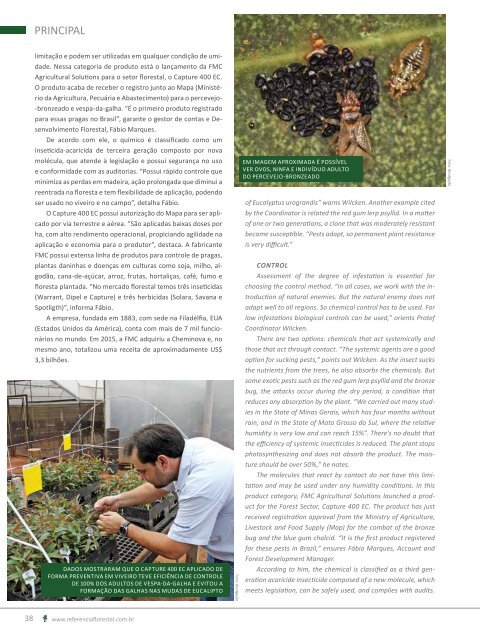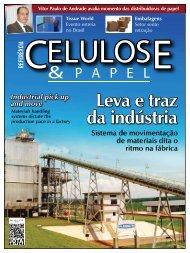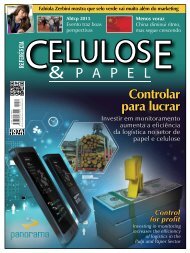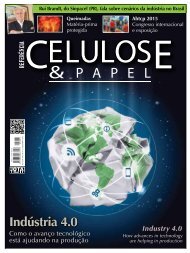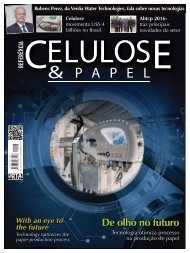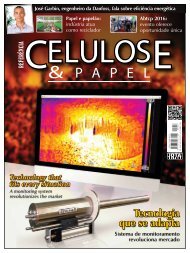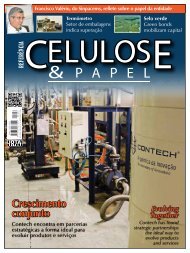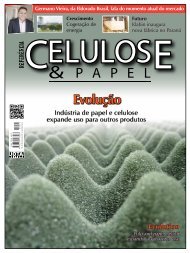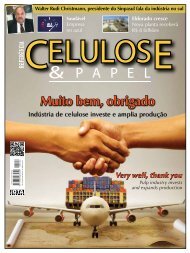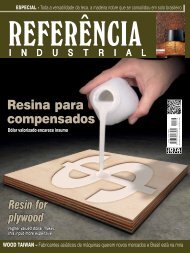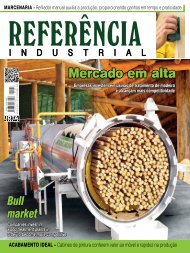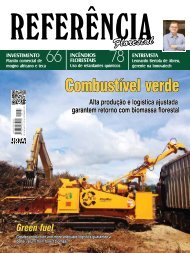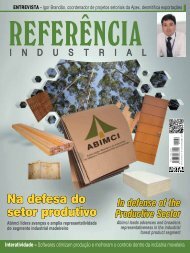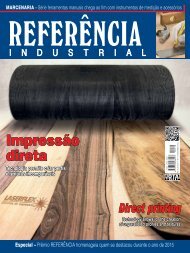Outubro/2016 - Referência Florestal 179
Visitantes - Grupo Jota Comunicação
Visitantes - Grupo Jota Comunicação
Create successful ePaper yourself
Turn your PDF publications into a flip-book with our unique Google optimized e-Paper software.
PRINCIPAL<br />
limitação e podem ser utilizadas em qualquer condição de umidade.<br />
Nessa categoria de produto está o lançamento da FMC<br />
Agricultural Solutions para o setor florestal, o Capture 400 EC.<br />
O produto acaba de receber o registro junto ao Mapa (Ministério<br />
da Agricultura, Pecuária e Abastecimento) para o percevejo-<br />
-bronzeado e vespa-da-galha. “É o primeiro produto registrado<br />
para essas pragas no Brasil”, garante o gestor de contas e Desenvolvimento<br />
<strong>Florestal</strong>, Fábio Marques.<br />
De acordo com ele, o químico é classificado como um<br />
inseticida-acaricida de terceira geração composto por nova<br />
molécula, que atende à legislação e possui segurança no uso<br />
e conformidade com as auditorias. “Possui rápido controle que<br />
minimiza as perdas em madeira, ação prolongada que diminui a<br />
reentrada na floresta e tem flexibilidade de aplicação, podendo<br />
ser usado no viveiro e no campo”, detalha Fábio.<br />
O Capture 400 EC possui autorização do Mapa para ser aplicado<br />
por via terrestre e aérea. “São aplicadas baixas doses por<br />
ha, com alto rendimento operacional, propiciando agilidade na<br />
aplicação e economia para o produtor”, destaca. A fabricante<br />
FMC possui extensa linha de produtos para controle de pragas,<br />
plantas daninhas e doenças em culturas como soja, milho, algodão,<br />
cana-de-açúcar, arroz, frutas, hortaliças, café, fumo e<br />
floresta plantada. “No mercado florestal temos três inseticidas<br />
(Warrant, Dipel e Capture) e três herbicidas (Solara, Savana e<br />
Spotligth)”, informa Fábio.<br />
A empresa, fundada em 1883, com sede na Filadélfia, EUA<br />
(Estados Unidos da América), conta com mais de 7 mil funcionários<br />
no mundo. Em 2015, a FMC adquiriu a Cheminova e, no<br />
mesmo ano, totalizou uma receita de aproximadamente US$<br />
3,3 bilhões.<br />
DADOS MOSTRARAM QUE O CAPTURE 400 EC APLICADO DE<br />
FORMA PREVENTIVA EM VIVEIRO TEVE EFICIÊNCIA DE CONTROLE<br />
DE 100% DOS ADULTOS DE VESPA-DA-GALHA E EVITOU A<br />
FORMAÇÃO DAS GALHAS NAS MUDAS DE EUCALIPTO<br />
Foto: divulgação<br />
EM IMAGEM APROXIMADA É POSSÍVEL<br />
VER OVOS, NINFA E INDIVÍDUO ADULTO<br />
DO PERCEVEJO-BRONZEADO<br />
of Eucalyptus urograndis” warns Wilcken. Another example cited<br />
by the Coordinator is related the red gum lerp psyllid. In a matter<br />
of one or two generations, a clone that was moderately resistant<br />
became susceptible. “Pests adapt, so permanent plant resistance<br />
is very difficult."<br />
CONTROL<br />
Assessment of the degree of infestation is essential for<br />
choosing the control method. “In all cases, we work with the introduction<br />
of natural enemies. But the natural enemy does not<br />
adapt well to all regions. So chemical control has to be used. For<br />
low infestations biological controls can be used,” orients Protef<br />
Coordinator Wilcken.<br />
There are two options: chemicals that act systemically and<br />
those that act through contact. “The systemic agents are a good<br />
option for sucking pests,” points out Wilcken. As the insect sucks<br />
the nutrients from the trees, he also absorbs the chemicals. But<br />
some exotic pests such as the red gum lerp psyllid and the bronze<br />
bug, the attacks occur during the dry period, a condition that<br />
reduces any absorption by the plant. “We carried out many studies<br />
in the State of Minas Gerais, which has four months without<br />
rain, and in the State of Mato Grosso do Sul, where the relative<br />
humidity is very low and can reach 15%”. There's no doubt that<br />
the efficiency of systemic insecticides is reduced. The plant stops<br />
photosynthesizing and does not absorb the product. The moisture<br />
should be over 50%,” he notes.<br />
The molecules that react by contact do not have this limitation<br />
and may be used under any humidity conditions. In this<br />
product category, FMC Agricultural Solutions launched a product<br />
for the Forest Sector, Capture 400 EC. The product has just<br />
received registration approval from the Ministry of Agriculture,<br />
Livestock and Food Supply (Map) for the combat of the bronze<br />
bug and the blue gum chalcid. “It is the first product registered<br />
for these pests in Brazil,” ensures Fábio Marques, Account and<br />
Forest Development Manager.<br />
According to him, the chemical is classified as a third generation<br />
acaricide insecticide composed of a new molecule, which<br />
meets legislation, can be safely used, and complies with audits.<br />
Foto: divulgação<br />
38<br />
www.referenciaflorestal.com.br


